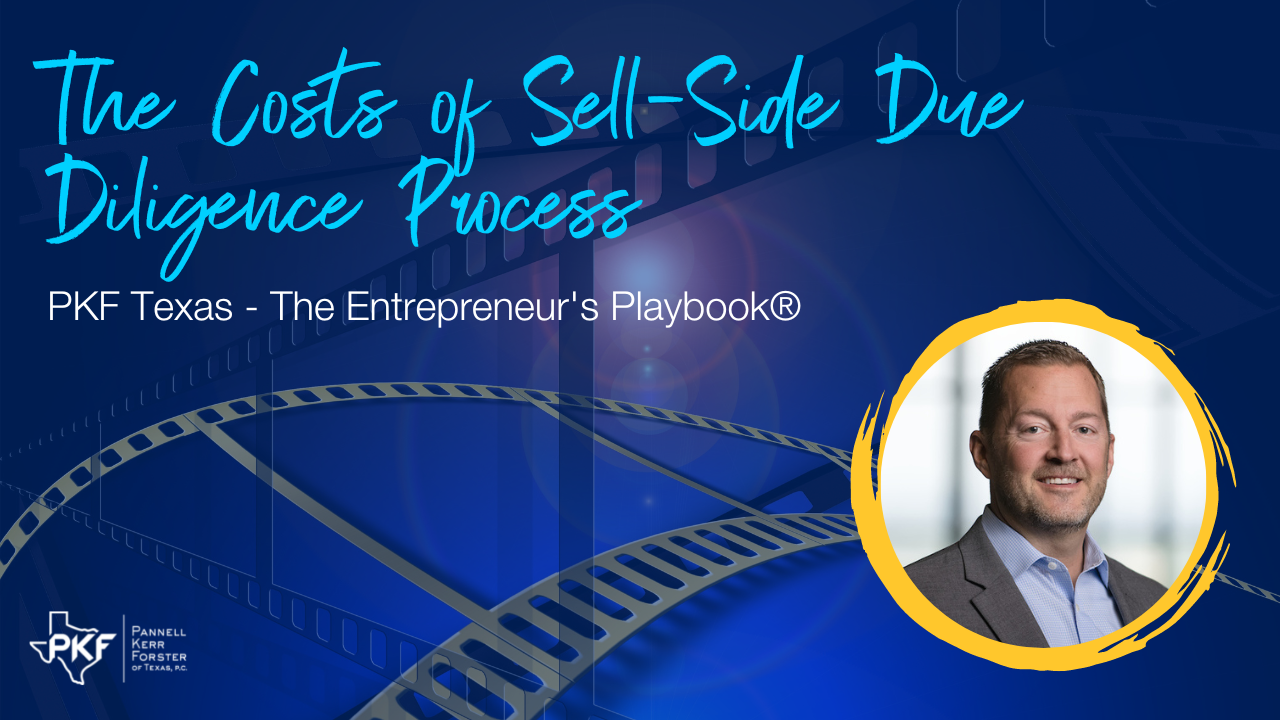The Costs of Sell-Side Due Diligence Process

When an investment banker refers an accounting firm to help with a business’ sell-side process, there is an additional cost, but fulfilling your due diligence has its benefits. In this next episode of PKF Texas – The Entrepreneur’s Playbook®, Audit and Transaction Advisory Services Director, Chris Hatten, CPA, CVA, CM&AA, discusses three key points for this process.
Jen: This is the PKF Texas – Entrepreneur’s Playbook®. I’m Jen Lemanski, and I’m back again with Chris Hatten, a Transaction Advisory Services Director here at PKF Texas. Chris, welcome back to the Playbook.
Chris: Appreciate it, Jen.
Jen: So, we’ve talked numerous times about various aspects of sell-side due diligence, but one thing we haven’t covered is the costs associated with going through that process. How do you advise on those costs? How do you set the stage with potential clients who are looking at going through that process? Take me through what that looks like.
Chris: Well, I’m going to more so focus on our costs because investment banks… they’re going to want their piece to go ahead and sell your business. And then of course, attorneys. And everybody knows there’s a fee associated with those two.
And so, a lot of times we get referred into the work through the investment bankers because they want to have a sell-side process done on their prospective clients to make sure that they’re ready to go through that and identify any issues. And candidly, one of the sticking points is it’s an additional cost. When we’re brought in and the investment bank does try and set us up as best they can, but sometimes we’ve got to talk about that, explain the benefits as well.
I think one of the biggest ones is that from the buyer’s perspective, it shows a commitment to the process by the seller. Because if they’re willing to go ahead and incur those costs to go through a sell-side process that they otherwise might not have had to, it shows that they’re ready and they’re serious about it.
And with the investment banks and private equity having to look at a bunch of deals – they look at hundreds and thousands every year – they’ve got somebody already in front of who is willing to spend that money. Once they’ve gotten through the sell-side QV process, there’s already some instant credibility as far as those numbers go because they’ve been vetted and helped the company that’s going through the sales process established their adjusted EBITDA. They’re still going to have to go through the buy-side process, but at least they’ve got one leg up on that process.
What also helps the seller is it prepares them to go through the buy-side process. So, it’s a dry run, but maybe not as painful because we want to work with the clients and not run them off. We say it’s kind of like a tune up and gets them ready to go through the process. And it can be pretty detailed depending on the size of the client or it can be a little bit scaled back if they are a smaller entity.
I haven’t come across a transaction yet where we haven’t incurred what we’ll call “speed bumps.” And these are the things that we want to iron out prior to taking the company to market. And so, if you can get those ironed out in advance, it’s one less thing that the buyer can sit there and start…
Jen: Well, and you might almost save some money down the road if you identify earlier in the process.
Chris: Yeah. It adds value to the process because when the prospective buyer comes in and they have their number, they start high and then they start whitling down as they come across what we call the hiccups, speed bumps, that kind of stuff. And so, if we can do something to help keep that number higher, then we’ve earned our payday at the end of it as well.
And then finally, I would say, and most importantly, we’re going through and we’re helping the seller identify what we call the non-recurring expenses. And just a quick example is, let’s say we come across a $15,000 adjustment that gets added back to EBITDA. And we’ll use a conservative figure, let’s say it’s a 6x multiple as far as this transaction. If you sit there and take that $15,000, multiply it by 6, and you come back with $90,000, that’s $90,000 that’s back in the seller’s pocket. And instantly covers our fees, and – I can’t guarantee everything – but more times than not, we come across multiple ones of these adjustments.
And so, they’ve already gone through that process and they’re handing over the seller, these are the type of things that we’ve already seen on our side. So, we think that the sell side process is not only good from a time standpoint, but as far as the savings that they could potentially save, or I say get back in their pocket at the end of the transaction, it’s well worth the investment.
Jen: Perfect. Well, we’ll get you back to talk a little bit more about this and all sorts of other transaction-related topics.
Chris: Look forward to it, Jen.
Jen: Great. Thanks. For more information about this and other transaction-related topics, visit PKFTexas.com/Insights. This has been another Thought Leader Production, brought to you by PKF Texas – The Entrepreneur’s Playbook®. Tune in next week for another chapter.

